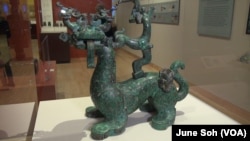A bianzhong, meaning ordered bells, greets visitors at the entrance of the special exhibition of rare Chinese musical instruments in the Musical Instrument Museum in Phoenix, Arizona. The approximately 2,600-year-old bronze bells were excavated from the tomb of a Chinese duke.
"This set of bells has 24 bells that are tuned to be part of a ritual ensemble from one of the courts during the spring and autumn period in the Kingdom of Zheng," Museum curator Colin Pearson explains, adding that the bells are for a special kind of music called "Zhengsheng."
The exhibition is a collaboration between the museum in Phoenix and the Henan Museum, one of the China's national museums in Henan Province. The collection of more than 60 unique and historic instruments, most of which came from excavated tombs, illustrates the entire breadth of the history of music in central China. None of them have been on display in the U.S. before.
The oldest instruments are tiny bone flutes that were made during the Neolithic or Peiligang culture 7,000 to 9,000 years ago.
"Archaeologists have found a number of flutes made from bird bones in Peiligang burials. These are collectively the oldest instruments in all of China," Pearson says.
From the bone flutes, the exhibit progresses through almost all of China’s major historical periods though the display of either instruments or artworks depicting music being performed, ending in the 20th century.
In one part of the exhibit, ceramic figurines illustrate the joyful mixing of cultures during the time of the Sui dynasty (581CE–618CE) at the height of the legendary Silk Road. In another, a ceramic model of a palatial home is displayed. One of many discovered in tombs from the Han Dynasty (206 BCE–220 CE), this one has flute players and dancers, suggesting the nobleman entombed was a music lover.
Divine beast
In addition to the instruments, themselves, the museum is displaying videos of replicas of the instruments being played.
Visitors are impressed with the sophistication of the music and its beauty.
"What I take away is amazement that the people from such ancient times can create precision instruments," David Patterson said.
"It is very beautiful," said visitor Barbara Patterson. “I felt like that you got a real good sense of how important music is in cultures and throughout the ages from the dawn of time. That it was important for their day-to-day life and even through death that so many things were left in the tomb with them so to carry throughout their extra life."
In the form of a "divine beast," an instrument stand occupies a corner of the exhibit. Two thousand 700 years old, it combines a dragon’s head, tortoise legs and a tiger’s body that is inlaid with phoenix birds - the harmonization of the four main symbols of the ancient philosophy of Taoism.
Pearson says the stand would have been used to support a drum in a ritual orchestra. "So we know this instrument stand would have been used in the highest-level ceremonies and sacrifices of the courts of Chu (1030 BCE–223 BCE)."
The instruments will go back to China when the exhibit ends on May 6.



